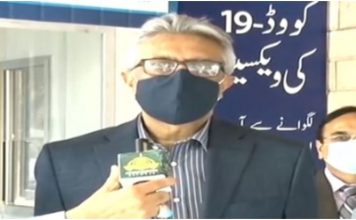LAHORE, Nov 04 (TNS): The Punjab Govt led by Chief Minister Shehbaz Sharif has proved once again why it is far ahead when it comes to meeting challenges with effectiveness.
Punjab Govt is up against the challenge of Smog now caused by the extensive corps burning in Indian side of Punjab. The vastness of the area, burning corps in, can be seen in the images released by NASA (the National Aeronautics and Space Administration).

It has pointed out that burning of crop stubbles may be a major reason for a smog blanket in New Delhi, and also in Lahore, as the map shows several places in West Punjab that have thermal emissions.
Both East and West Punjab have two growing seasons — one from May to September and the other from November to April. In May and November, Punjab farmers typically sow crops and vegetables for the next season; but before sowing, they often set fire to fields to clear stubbles of previous crop and make them suitable for next sowing.
Particles produced by burning corps have spread in the air due to which not only people across the border from Indian Capital Delhi to Bhakkar in the west and Multan, Bahawalpur in the south are facing health and commutation problems but also the visibility has plunged to the extent that road accidents have become order of the day.
According to Motorway officials, visibility has plunged to 25 -50 meters from Lahore to Bhera, as thick smog an unwanted by-product of fog and pollution continued to persist in the air. Many have died and been injured in traffic accidents.
Lahore and its suburbs in particular have got blanketed by the smog causing many problems to millions of people.

Punjab Environment Minister Begum Zakia Shah talking to the media told the neighboring state burnt 35 million tons of waste which caused air pollution. The polluted air was carried to the Pakistani side by eastern winds and such climatic conditions occurred which made the smog static in Punjab.
The Punjab Govt under the leadership of Chief Minister Shehbaz Sharif has responded quickly by coming up with Smog Policy Action Plan.
Under the action plan, apart from sealing 175 Furnace units, ban has been imposed on crop burning under section 144 of Criminal Procedure Code with 151 FIR’s registered against violators and 43 arrests, besides 15718 polluting vehicles fined an amount of Rs 4,658,398 and 1,170 vehicles impounded.

To raise awareness in this regard Punjab Govt has contacted 280000 farmers in 22000 villages and SMS based campaign launched using PDMA’s existing facilities.
Six Air Quality Units have also been deployed by Punjab EPA, for the first time in Pakistan.
The Punjab government has instituted a number of emergency measures to mitigate the pollution, which include banning the burning of agricultural waste and closing steel mill factories. “We sealed steel mills who have not installed air pollution control devices,” says Punjab EPA director Waseem Cheema.

We also intend to cut the number of cars on the road to control vehicular pollution. The government is creating awareness to reduce traffic load. People should know how much we are contributing in creating environmental pollution.
We are trying to control vehicular pollution. This includes from two-stroke [auto] rickshaws and from old vehicles that need proper tuning and inspection. To this end, the EPA has imposed more frequent road checks by teams of a traffic policeman, an official from a regional transport authority and an environmental inspector.
Vehicles failing basic maintenance requirements are fined or impounded, and in the most extreme cases, the police may register a case against the owner in the court of the environmental magistrate.

Environment Protection Department is closely monitoring rice stubble burning activities in the Punjab as well as in the region using inter alia satellite data obtained through various sources including Space and Upper Atmosphere Research Commission (SUPARCO) and timely informing all relevant agencies for adopting suitable mitigation measures.
This information is being supplemented with air quality parameters observed through monitoring stations available with the Environmental Protection Agency.
Open burning being the major source of smog, every year, in the early October; Home Department has imposed a complete ban on open burning of rice stubble, solid waste and other hazardous materials. This ban shall be implemented through the respective Deputy Commissioners and District Police Officers. Similar instructions have been passed to their field offices by Agriculture and Local Government Departments

Other measures: In the event of a forecast or actual smog event, immediate advisories shall be issued in the following manner: a. Environment Protection Department shall issue advisory to all concerned departments based on the Air Quality Index (AQI) for PM2.5 and other parameters; b. Primary and Secondary Health Care Departments shall issue health advisory and ensure its maximum dissemination including through such means as paper, electronic, and social media. c. Additional Inspector General of Traffic shall issue advisory on use of roads, especially highlighting the forecasted or prevailing visibility levels and their likely impact of safe use of roads.
If the situation demands, masks shall be distributed at schools and selected public places in the most affected districts by respective Deputy Commissioners.














